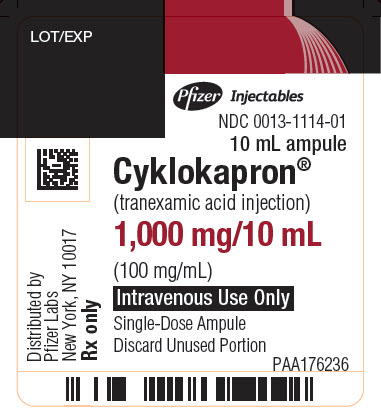FDA records indicate that there are no current recalls for this drug.
Are you a medical professional?
Trending Topics
Cyklokapron Recall
Get an alert when a recall is issued.
Questions & Answers
Side Effects & Adverse Reactions
Focal areas of retinal degeneration have developed in cats, dogs, and rats following oral or intravenous tranexamic acid at doses between 250 to 1600 mg/kg/day (6 to 40 times the recommended usual human dose) from 6 days to 1 year. The incidence of such lesions has varied from 25% to 100% of animals treated and was dose-related. At lower doses, some lesions have appeared to be reversible.
Limited data in cats and rabbits showed retinal changes in some animals with doses as low as 126 mg/kg/day (only about 3 times the recommended human dose) administered for several days to two weeks.
No retinal changes have been reported or noted in eye examinations in patients treated with tranexamic acid for weeks to months in clinical trials.
However, visual abnormalities, often poorly characterized, represent the most frequently reported postmarketing adverse reaction in Sweden. For patients who are to be treated continually for longer than several days, an ophthalmological examination, including visual acuity, color vision, eye-ground, and visual fields, is advised, before commencing and at regular intervals during the course of treatment. Tranexamic acid should be discontinued if changes in examination results are found.
Convulsions have been reported in association with tranexamic acid treatment, particularly in patients receiving tranexamic acid during cardiovascular surgery and in patients inadvertently given tranexamic acid into the neuraxial system.
Legal Issues
There is currently no legal information available for this drug.
FDA Safety Alerts
There are currently no FDA safety alerts available for this drug.
Manufacturer Warnings
There is currently no manufacturer warning information available for this drug.
FDA Labeling Changes
There are currently no FDA labeling changes available for this drug.
Uses
CYKLOKAPRON Injection is indicated in patients with hemophilia for short-term use (two to eight days) to reduce or prevent hemorrhage and reduce the need for replacement therapy during and following tooth extraction.
History
There is currently no drug history available for this drug.
Other Information
Each mL of the sterile solution for intravenous injection contains 100 mg tranexamic acid and Water for Injection to 1 mL.
Chemical Name: trans-4-(aminomethyl)cyclohexanecarboxylic acid
Structural Formula:
Tranexamic acid is a white crystalline powder. The aqueous solution for injection has a pH of 6.5 to 8.0.
Sources
Cyklokapron Manufacturers
-
Pharmacia And Upjohn Company
![Cyklokapron (Tranexamic Acid) Injection, Solution [Pharmacia And Upjohn Company]](/wp-content/themes/bootstrap/assets/img/loading2.gif)
Cyklokapron | Pharmacia And Upjohn Company
![Cyklokapron (Tranexamic Acid) Injection, Solution [Pharmacia And Upjohn Company] Cyklokapron (Tranexamic Acid) Injection, Solution [Pharmacia And Upjohn Company]](/wp-content/themes/bootstrap/assets/img/loading2.gif)
Immediately before tooth extraction in patients with hemophilia, administer 10 mg per kg body weight of CYKLOKAPRON intravenously together with replacement therapy (see PRECAUTIONS). Following tooth extraction, intravenous therapy, at a dose of 10 mg per kg body weight three to four times daily, may be used for 2 to 8 days.
Note: For patients with moderate to severe impaired renal function, the following dosages are recommended:
Serum Creatinine (µmol/L) Tranexamic Acid Intravenous Dosage 120 to 250 (1.36 to 2.83 mg/dL) 10 mg/kg twice daily 250 to 500 (2.83 to 5.66 mg/dL) 10 mg/kg daily >500 (>5.66 mg/dL) 10 mg/kg every 48 hours
or
5 mg/kg every 24 hoursFor intravenous infusion, CYKLOKAPRON Injection may be mixed with most solutions for infusion such as electrolyte solutions, carbohydrate solutions, amino acid solutions, and Dextran solutions. Heparin may be added to CYKLOKAPRON Injection. CYKLOKAPRON Injection should NOT be mixed with blood. The drug is a synthetic amino acid, and should NOT be mixed with solutions containing penicillin.
Single-dose vials and ampulesDiscard CYKLOKAPRON vial or ampule and any remaining portion in the vial/ampule after single use.
The diluted mixture may be stored for up to 4 hours at room temperature prior to patient administration.
Login To Your Free Account


